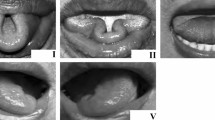Abstract
Pharyngeal manometry complements the modified barium swallow with videofluoroscopy (VFS) in diagnosing pressure-related causes of dysphagia. When manometric analysis is not feasible, it would be ideal if pressure information about the swallow could be inferred accurately from the VFS evaluation. Swallowing function was examined using VFS and concurrent manometry in 18 subjects (11 head and neck patients treated with various modalities and 7 healthy adults). Nonparametric univariate and multivariate analyses revealed significant relationships between manometric and fluoroscopic variables. Increases in pressure wave amplitude were significantly correlated with increased duration of tongue base to pharyngeal wall contact, reduced bolus transit times, and oropharyngeal residue. Pharyngeal residue was the most important VFS variable in reflecting pharyngeal pressure measurements. Certain VFS measures were significantly correlated with measures of pressure assessed with manometry. Further research is needed before observations and measures from VFS alone may be deemed sufficient for determining pressure-generation difficulties during the swallow in patients who are unable or unwilling to submit to manometric testing.
Similar content being viewed by others
References
Castell JA, Dalton CB, Castell DO. Pharyngeal and upper esophageal sphincter manometry in humans. Am J Physiol. 1990;258:G173–8.
Ergun GA, Kahrilas PJ, Logemann JA. Interpretation of pharyngeal manometric recordings: limitations and variability. Dis Esophagus. 1993;6:11–6.
Kahrilas PJ, Logemann JA, Lin S, Ergun GA. Pharyngeal clearance during swallow: a combined manometric and videofluoroscopic study. Gastroenterology. 1992;103:128–36.
Jacob P, Kahrilas P, Logemann J, Shah V, Ha T. Upper esophageal sphincter opening and modulation during swallowing. Gastroenterology. 1989;97:1469–78.
Malhi-Chowla N, Achem SR, Stark ME, DeVault KR. Manometry of the upper esophageal sphincter and pharynx is not useful in unselected patients referred for esophageal testing. Am J Gastroenterol. 2000;95:1417–21.
Ali GN, Wallace KL, Laundl TM, Hunt DR, deCarle DJ, Cook IJ. Predictors of outcome following cricopharyngeal disruption for pharyngeal dysphagia. Dysphagia. 1997;12(3):133–9.
Cook IJ. Cricopharyngeal function and dysfunction. Dysphagia. 1993;8(3):244–51.
Olsson R, Castell JA, Castell DO, Ekberg O. Solid-state computerized manometry improves diagnostic yield in pharyngeal dysphagia: simultaneous videoradiography and manometry in dysphagia patients with normal barium swallows. Abdom Imaging. 1995;20(3):230–5.
Ali GN, Wallace KL, Schwartz R, DeCarle DJ, Zagami AS, Cook IJ. Mechanisms of oral-pharyngeal dysphagia in patients with Parkinson’s disease. Gastroenterology. 1996;110(2):383–92.
Hila A, Castell JA, Castell DO. Pharyngeal and upper esophageal sphincter manometry in the evaluation of dysphagia. J Clin Gastroenterol. 2001;33:355–61.
Cook IJ, Kahrilas PJ. AGA technical review on management of oropharyngeal dysphagia. Gastroenterology. 1999;116:455–78.
Podas T, Eaden J, Mayberry M, Mayberry J. Achalasia: a critical review of epidemiological studies. Am J Gastroenterol. 1998;93:2345–47.
Leonard R, Belafsky PC, Rees CJ. Relationship between fluoroscopic and manometric measures of pharyngeal constriction: the pharyngeal constriction ratio. Ann Otol Rhinol Laryngol. 2006;115:897–901.
Rubenstein EB, Peterson DE, Schubert M, Keefe D, McGuire D, Epstein J, et al. Mucositis Study Section of the Multinational Association for Supportive Care in Cancer; International Society for Oral Oncology, Clinical practice guidelines for the prevention and treatment of cancer therapy-induced oral and gastrointestinal mucositis. Cancer. 2004;100(9 Suppl):2026–46.
Dejaeger E, Pelemans W, Ponette E, Joosten E. Mechanisms involved in postdeglutition retention in the elderly. Dysphagia. 1997;12:63–7.
Acknowledgment
This work was funded by the National Institutes of Health grant NIH/NCI P01CA40007.
Author information
Authors and Affiliations
Corresponding author
Rights and permissions
About this article
Cite this article
Pauloski, B.R., Rademaker, A.W., Lazarus, C. et al. Relationship Between Manometric and Videofluoroscopic Measures of Swallow Function in Healthy Adults and Patients Treated for Head and Neck Cancer with Various Modalities. Dysphagia 24, 196–203 (2009). https://doi.org/10.1007/s00455-008-9192-x
Received:
Accepted:
Published:
Issue Date:
DOI: https://doi.org/10.1007/s00455-008-9192-x




